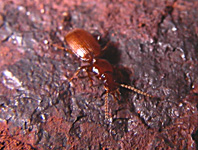Abstract
A new species of myxosporean parasite is described from the gall bladders of the hakes Merluccius capensis Castelnau and M. paradoxus Franca (Pisces: Teleostei) caught off the west and south coasts of South Africa. The new species, Pseudalataspora vanderlingeni, is described morphologically and molecularly and compared with the 15 other species of Pseudalataspora previously described from marine fish. Although a molecular description is available on GenBank for only one of these 15 species, the morphological description supports the status of P. vanderlingeni as a new species. Earlier reports, without detailed descriptions, of Leptotheca sp. and Ceratomyxa sp. from the same hosts caught off Namibia were very likely to have been of P. vanderlingeni. These earlier studies reported high prevalences of infection, similar to those of >60% described in the present study. The effects of fixation and freezing on the dimensions of spores of Pseudalataspora spp. are described, and the status of the genus Pseudalataspora within the family Ceratomyxidae is discussed.
References
Aleshkina, L.D. (1982) Parasite fauna of Cape hake and dependence of its species composition on age of host. Hydrobiological Journal, 18, 56–58.
Altschul, S.F., Gish, W., Miller, W., Myers, E.W. & Lipman, D.J. (1990) "Basic local alignment search tool." Journal of Molecular Biology, 215, 403–410.
https://doi.org/10.1016/S0022-2836(05)80360-2Barta, J.R., Martin, D.S., Liberator, P.A., Dashkevicz, M., Anderson, J.W., Feighner, S.D., Elbrecht, A., Perkins-Barrow, A., Jenkins, M.C., Danforth, H.D., Ruff, M.D. & Profous-Juchelka, H. (1997) Phylogenetic relationships among eight Eimeria species infecting domestic fowl inferred using complete small subunit ribosomal DNA sequences. Journal of Parasitology, 83, 262–271.
https://doi.org/10.2307/3284453Fantham, H.B. (1930) Some parasitic protozoa found in South Africa. XIII. South African Journal of Science, 27, 376–390.
Fiala, I. (2006) The phylogeny of Myxosporea (Myxozoa) based on small subunit ribosomal RNA gene analysis. International Journal for Parasitology, 36, 1521–1534.
https://doi.org/10.1016/j.ijpara.2006.06.016Froese, R. & Pauly, D. (Eds.) (2016) FishBase. World Wide Web electronic publication.
Gunter, N.L. & Adlard, R. (2010) The demise of Leptotheca Thélohan, 1895 (Myxozoa: Myxosporea: Ceratomyxidae) and assignment of its species to Ceratomyxa Thélohan, 1892 (Myxosporea: Ceratomyxidae) Ellipsomyxa Køie, 2003 (Myxosporea: Ceratomyxidae), Myxobolus Bütschli, 1882 and Sphaerospora Thélohan, 1892 (Myxosporea: Sphaerosporidae). Systematic Parasitology, 75, 81–104.
https://doi.org/10.1007/s11230-009-9227-1Hall, T.A. (1999) BioEdit: a user-friendly biological sequence alignment editor and analysis program for Windows 95/98/NT. Nucleic Acids Symposia Series, 41, 95–98.
Kalavati, C., MacKenzie, K., Collins, C., Hemmingsen, W. & Brickle, P. (2013) Two new species of myxosporean parasites (Myxosporea: Bivalvulida) from gall bladders of Macruronus magellanicus Lönnberg, 1907 (Teleostei: Merluccidae). Zootaxa, 3647 (4), 541–554.
https://doi.org/10.11646/zootaxa.3647.4.4Kumar, S., Stecher, G. & Tamura, K. (2016) Molecular Evolutionary Genetics Analysis version7.0 for bigger datasets. Molecular Biology and Evolution, 33, 1870–1874.
https://doi.org/10.1093/molbev/msw054Nei, M. & Kumar, S. (2000) Molecular Evolution and Phylogenetics. Oxford University Press, New York, 333 pp.
Posada, D. & Crandall, K.A. (1998) Testing the model of DNA substitution. Bioinformatics, 14, 817–818.
https://doi.org/10.1093/bioinformatics/14.9.817Reimer, L.W. (1993) Parasites of Merluccius capensis and M. paradoxus from the coast of Namibia. Applied Parasitology, 34, 143–150.
Rocha, S., Casal, G., Rangel, L., Castro, R., Severino, R., Azevedo, C. & Santos, M.J. (2015) Ultrastructure and phylogeny of Ceratomyxa auratae n. sp. (Myxosporea: Ceratomyxidae), a parasite infecting the gilthead seabream Sparus aurata (teleostei: Sparidae). Parasitology International, 64, 305–313.
https://doi.org/10.1016/j.parint.2015.04.002Sarkar, N.K. (2012) Three new species of Myxosporea (Bivalvulida), parasites of the gallbladder of scombrid fish, from the Bay of Bengal, Indian Ocean, West Bengal, India. Protistology, 7 (3), 172–177.
Swofford, D.L. (1999) PAUP*: Phylogenetic analysis using parsimony (*and other methods). Version. 4.0. Sinauer Associates, Sunderland, Massachusetts. [software]
Zhang, Z., Schwartz, S., Wagner, L. & Miller, W. (2000) A greedy algorithm for aligning DNA sequences. Journal of Computational Biology, 7, 203–214.
https://doi.org/10.1089/10665270050081478

